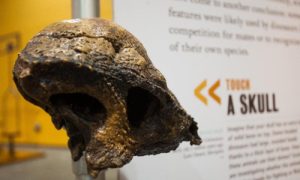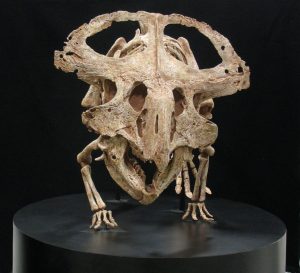A special exhibit, Dinosaur Discoveries: Ancient Fossils, New Ideas, is set to open at the Virginia Museum of Natural History (VMNH) in Martinsville on Saturday, February 11. The exhibit will reveal a vivid picture of what living, breathing dinosaurs were really like, explore how current thinking about dinosaur biology has changed over the past two decades, and highlight current research by scientists from the American Museum of Natural History (AMNH) and other leading paleontologists around the world.

Using a combination of fossil finds, captivating computer simulations, and provocative models, Dinosaur Discoveries: Ancient Fossils, New Ideas introduces a dynamic vision of dinosaurs and the scientists who study them. The exhibit examines, in great detail, recent scientific sleuthing and the array of investigative tools—from bioengineering computer software to CT scans—used by modern scientists to reinterpret many of the most persistent and puzzling mysteries of dinosaurs: what they looked like, how they behaved, and how they moved. It also explores the complex and hotly debated theories of why—or even whether—they became extinct.
“This exhibition illustrates how scientists are using new ideas, new discoveries, and new technologies to revolutionize our understanding of dinosaurs,” says Mark A. Norell, curator of Dinosaur Discoveries and curator emeritus in the Division of Paleontology at the American Museum of Natural History. “Our work reaches across many disciplines involving paleontologists, biomechanical engineers, paleobotanists, and others to showcase how we go about reconstructing the mysterious life of dinosaurs.”
Dinosaur Discoveries: Ancient Fossils, New Ideas is divided into several major themes, including:
How Dinosaurs Moved
In this section, biomechanical studies on dinosaur movement spring dramatically to life. Highlights include:

A video on T. rex depicting how experts in biomechanics and paleontology are teaming up to estimate the typical speed and gait of a rampaging tyrannosaur.
A full-size cast skeleton leg of a Tyrannosaurus rex.
A stunning model of an Apatosaurus skeleton neck, whose construction has been based on computer drawings used to investigate the full range of vertebral movements of this huge, long-necked creature.
A high-definition video array on the wall directly behind the Apatosaurus neck displays a computer animation of the steel robo-dinosaur skeleton that morphs into a realistic fossil skeleton and then gradually adds layers of muscle and skin until a full-fleshed Apatosaurus is moving on the screens.
The Liaoning Forest
This portion of the exhibit includes a diorama depicting a section of a 130-million-year-old forest that existed in what is now Liaoning Province, China. Fossil discoveries from Liaoning have shed light on the origins of birds, mammals, feathers, flight, and flowering plants.
How Dinosaurs Behaved
This section demonstrates how scientists are reinterpreting old fossil evidence using new approaches and new technologies to unlock the secrets of dinosaur behavior. Life-size models and skeleton casts illustrate theories on the purposes of the unusual horns, frills, crests, and domes found on many dinosaur skulls. Were they used for defense, mate recognition, or display? Highlights include:
A case featuring various skulls, plates, and other armor.
Twin life-size models of Protoceratops – one skeleton, the other fully fleshed out.
A life-size three-horned Triceratops skull.
Extinction
In this section, visitors can explore the hard evidence for theories on the possible events that ended the Age of Dinosaurs, including an asteroid impact, global climate change, and massive volcanic eruptions, as well as the descendants of dinosaurs that walk among us today.
“The museum constantly strives to provide our visitors with new and unique experiences,” said VMNH Deputy Director Ryan Barber. “Working with the American Museum of Natural History to bring such an immersive, dinosaur-themed exhibit to VMNH will give visitors another memorable experience that compliments the many dinosaur displays that the museum already exhibits on a permanent basis.”
Dinosaur Discoveries: Ancient Fossils, New Ideas is exhibited at the Virginia Museum of Natural History from February 11 through January 20, 2024.
Admission to the special exhibit is included in the price of general museum admission. Museum admission is $10 per adult ages 18-59 and $5 for children and youth ages 3-17, seniors ages 60+, and college students. Admission is free for children under 3, museum members, and members of museums and science centers that participate in the ASTC Passport program.
The museum also participates in the Institute for Museum and Library Services Museums for All initiative, offering discounted admission to EBT cardholders. Through this program and additional funding provided by Hooker Furnishings, visitors who present their EBT card and accompanying ID at the museum’s box office receive free museum admission.
Dinosaur Discoveries: Ancient Fossils, New Ideas is organized by the American Museum of Natural History, New York (www.amnh.org), in collaboration with the California Academy of Sciences, San Francisco; The Field Museum, Chicago; the Houston Museum of Natural Science; and the North Carolina Museum of Natural Sciences, Raleigh.
To learn more about VMNH, visit www.vmnh.net.
To learn more about the American Museum of Natural History, visit amnh.org.




